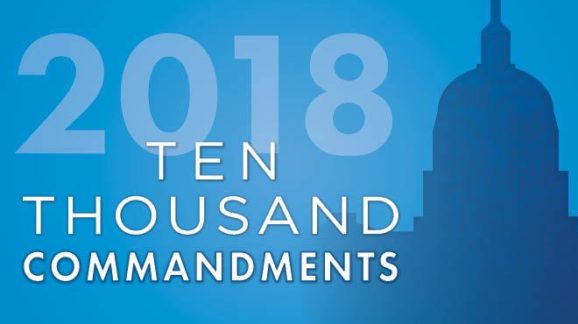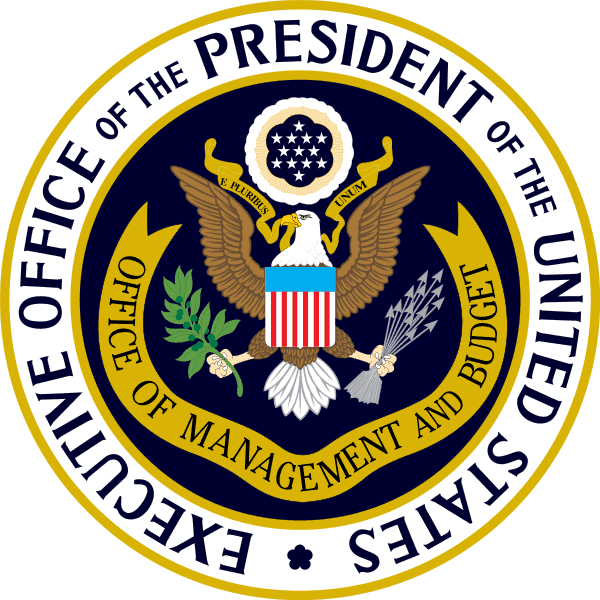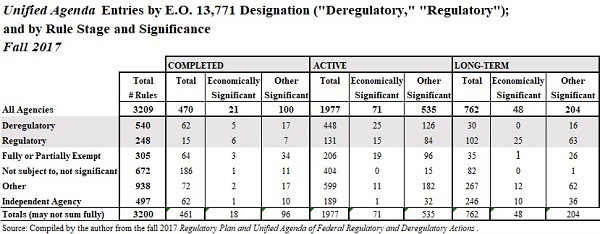Federal Deregulation Can Exceed What Gets Reported in Unified Agenda

 In tracking the Trump administration’s regulatory vs. deregulatory actions, there can be discrepancy between the official Unified Agenda compilation (the tally that’s been around since the early ’80s) and other White House status updates.
In tracking the Trump administration’s regulatory vs. deregulatory actions, there can be discrepancy between the official Unified Agenda compilation (the tally that’s been around since the early ’80s) and other White House status updates.
Examining this difference with respect to the administration’s detailed December 2017 update on the “one-in, two-out” regulatory campaign will set the stage for a follow-up post covering deregulatory actions in the new Spring Unified Agenda.
The Trump administration seeks to reduce significant regulations. Some will recall the “22-to-1” success boast by the administration in its “Two-for-One Status Report and Regulatory Cost Caps.” As long as costs are net zero, the primary presecription of Trump’s executive order 13,771, it is acceptable to apply non-significant rules for credit toward the two-for-one goal, and some of that was certainly going on.
The Unified Agenda’s “Completed” component is the official/historical compilation one might expect to correspond to the administration’s claims. But where the administration indicated 67 deregulatory actions in its Status Report, the Agenda identified 62 “Completed” deregulatory actions (see Table 8 in the latest 2018 edition of “10,000 Commandments,” below).

Why the difference? One reason is that some removals were achieved via the Congressional Review Act (with “resolutions of disapproval” passed and signed into law by the president) and therefore do not appear in the Agenda, which assembles regulatory actions only.
Another part of the discrepancy is due to the fact that nine of Trump’s rule cuts involved agency sub-regulatory guidance documents or notices or other proclamations, some of which do not appear in the Agenda (These nine appear in bold-type in Box 2 in “10,000 Commandments” and also in un-highlighted form here).
Still another difference between the two tabulations, but in the opposite direction, is that the administration (for whatever reason) did not take credit for each of the “economically significant” rules eliminated. As the “Table 8” referenced above also shows, of the 62 Completed “Deregulatory” actions in the Agenda, five are in the “economically significant” category. However, the administration noted only one of these (repeal of the Fair Pay and Safe Workplaces Rule) in its “Two-for-One Status Report.”
On the flip-side, sometimes there can be more regulation underway or lurking than gets acknowledged.
In its roundup, the administration pointed to three completed “significant regulatory actions” that had been adequately offset on the claimed 22-for-one basis. Actually, 15 completed regulatory actions appeared in the fall Agenda, with six of them deemed “economically significant.” For purposes of executive order 13,771, such significant regulations are required to be offset, but even with six economically significant actions rather than three completed, the overall two-for-one goal was still met given (at least) 62 deregulatory actions.
That is, even taking into account the presence of 15 completed regulatory actions under the Unified Agenda database’s executive order 13,771 Designation, the two-for-one target was still attained at a four-for-one ratio (The 62 “Deregulatory” actions divided by the 15 “Regulatory” ones in Table 8).
Notably, while there were six Completed regulatory rules at the economically significant level in the Fall Unified Agenda, there were only five deregulatory ones of comparable signifiance (Table 8 again). One takeaway: It is worrisome with respect to longer-term prospects that non-economically signficant Deregulatory rules are carrying the weight of offsetting the economically significant Regulatory ones.
The new Spring 2018 Unified Agenda was accompanied with claims of ongoing success, however without the same high level of cheerleading seen in 2017. Regulatory liberalization is not an eay thing to achieve, given the scope of today’s vast administrative state.
It is within the above context that an upcoming column will examine completed regulatory and deregulatory actions in the new Spring Agenda, which I outlined earlier here. To show the full scope of deregulation, the administration should continue issuing supplemental status reports that cover what goes beyond, such as the reductions in guidance documents.